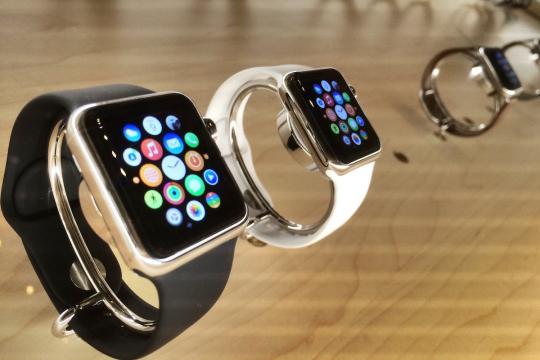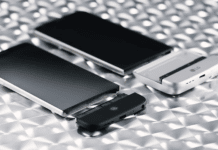
The Watch is essentially an iPhone accessory
Whilst you’re made aware that you should only buy this product if you’re an iPhone owner, when you start using it you find that it is essentially a Bluetooth accessory, albeit a very fancy and clever one. It must be near to your phone to do pretty much anything except tell the time, listen to any music you’ve loaded onto the watch (up to 1GB, though this doesn’t include streaming music such as Spotify) and check health stats. It’s obvious why Apple made this compromise, because for the watch to have its own internet connection and more processing power it would have to be unwearably huge.
But it’s not an iPhone on your wrist
Whilst it’s an extension of your iPhone it’s a totally different device with different uses. It is not, for instance, at all useful for consuming content. Apps like Instagram, Digg or Guardian quickly go in the bin (though the latter’s alerts are useful). This is all about quick access to the most boiled down information and notifications. Once you realise this you go searching for apps you never thought about needing before…
You discover the App Store all over again
The apps you use on your phone most probably aren’t the ones you’ll use on your Watch. Your wrist is no place for the Facebook feed, Instagram, blog feeds or even Twitter. You start to want the essential data – minutes until next train home, miles cycled this week, time of high tide today, next calendar event, number of visitors to your site today etc, as well as one-tap utilities. There are great apps like Numerous which can help pull numbers from all over the place, as well as the IFTTT apps which allow you to create buttons to do all kinds of stuff from warming up your house to sending a map of your location to your partner instantly.
Some of the big apps are a disappointment
Another reason to go hunting in the App Store is that many of the apps you’re familiar with haven’t done a great job of extending their offering to your wrist. To be fair that is because no-one really knows how we’ll ultimately use this new device, and possibly some were rushed, but Twitter for instance shows either Top Trends or Timeline. The format and layout is fine but is that what you really want on your wrist? Would interactions be more important? The Apple apps are mostly fine but you’ll likely find better alternatives in the App Store such as Dark Sky’s superior weather app with brilliantly useful forecasts.
You need some time to properly set it up
Out of the box the watch is great. It pairs with your iPhone and automatically loads Watch extensions for any apps on your phone. However, for most users who have a lot of iPhone apps this causes instant bloat of the Watch homescreen, glances and notifications. You have to rethink how you want those apps to talk to you, and more fundamentally what information you actually want on your wrist. It took me hours and mostly involved turning off existing iPhone apps, trying new apps for different things and endlessly tweaking the settings using the Apple Watch app on my iPhone.
You’ll likely reactivate notifications
If, like me, you’ve switched all notifications off for all but the crucial apps (Phone, Twitter and WhatsApp for me), you’re likely to re-activate some of those for the Watch. Whilst I’m generally against being nagged by technology I’m currently enjoying being told about impending rain showers, breaking news and travel disruptions. Fortunately you can set different notification rules between your iPhone and Watch using the Apple Watch iPhone app.
This is a classic first version of a new Apple product
Using the Apple Watch it’s pretty easy to see where the improvements will come in future versions. They simply revolve around speed, reliance on iPhone and possibly screen resolution. The first two are related because everything on the Watch that relies on the web takes a few seconds to use your iPhone’s connection and possibly runs the app in the background on your phone to process that information. I also suspect the Watch isn’t packing a huge amount of CPU or RAM. If it was a standalone device everything would be quicker and there would of course be a much larger market for it outside of iPhone users. The screen resolution is already impressive but will no doubt be something they can boast about raising next year.
Apps hold the key to this being a truly mainstream product
Now it’s over to app developers to experiment, listen to users and create highly useful snippets of functionality from their iPhone apps. There are already thousands of compatible apps, but it will take time for them to be refined in response to how we use them.
But will the Watch endure?
With this new product line, Apple could be guilty of solving a problem we never had, which is usually a recipe for a fad. My personal opinion is that this is just early days, and the mainstream will start to care about Apple Watch once there are more apps and genuinely useful reasons to have it. Wearable technology and voice-activated cloud intelligence like Siri are advancing and converging fast. What our ’smart’ future looks like is unclear, but only by getting products like Watch to market can Apple find out, and have a chance of leading the smart revolution.
Want to learn new creative and marketing skills with me? Check out upcoming courses on topics like SEO, content marketing, copywriting and podcasting.
What's trending in digital marketing?
Stay on top of the latest news, tips, tools and updates in digital. Just for people in marketing and business. No fluff, no ads, no spam.
Join thousands of readers keeping abreast with it all, every Thursday.

















